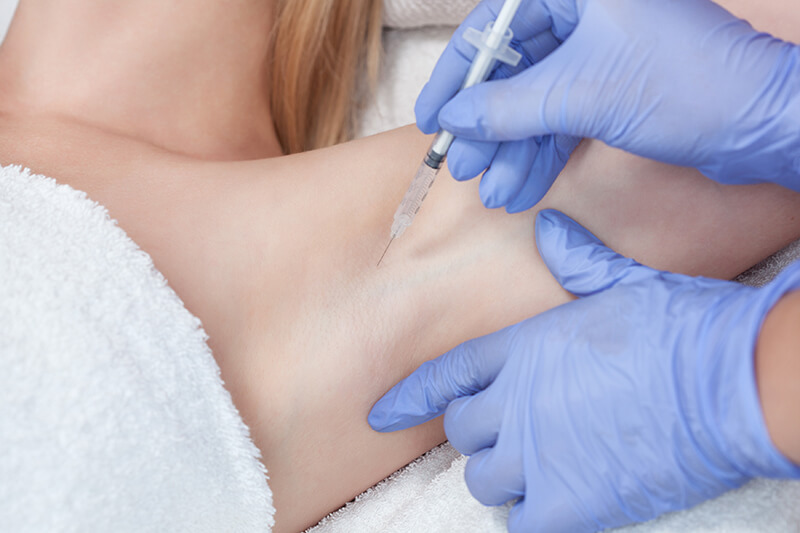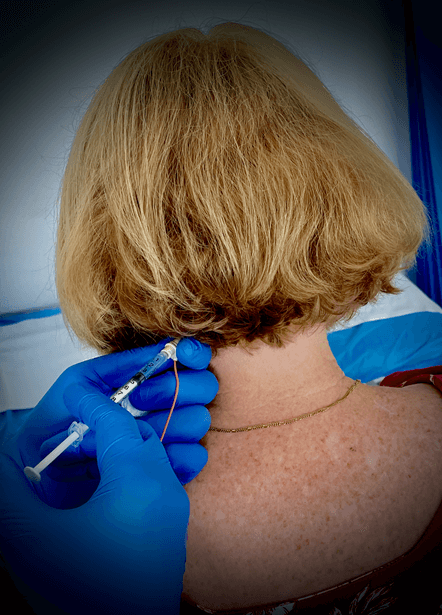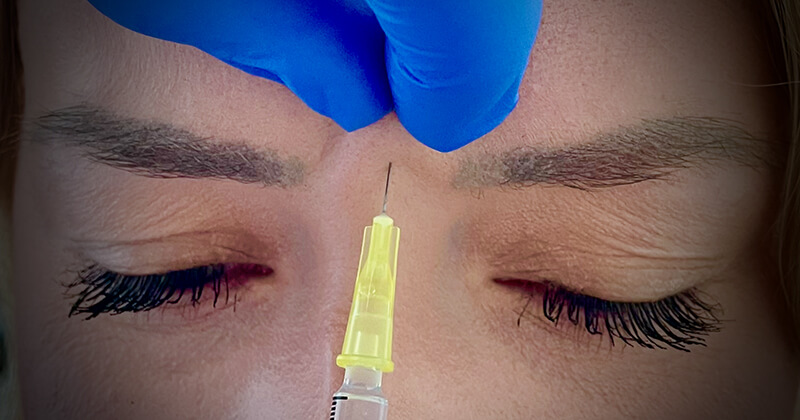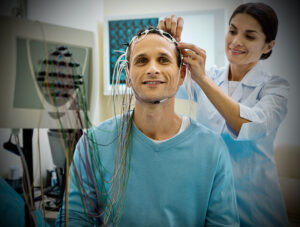Commonly used word Botox® is a trade name for Botulinum toxin (another common one being Dysport®).
Use of Botulinum toxin is much wider in medicine than in cosmetics and, within medicine, it is used most extensively for neurological conditions. Botulinum toxin treatment is administered in the consultation room, mostly while sitting in a chair and occasionally lying down using sterile single use equipment. Injections can be uncomfortable but are mostly tolerated very well.
The exact treatment dose and technique depends on the condition. Sometimes a special needle with electrical sensor is used for accurate delivery of the toxin. treatment in conditions like dystonia. It is connected to a machine able to sense the electrical activity of the muscle. This ensures the tip of the needle is exactly in the desired spot enabling precise delivery of the toxin.
Dr. Sheikh also uses ultrasound alongside to enhance precision of the targeted injections. Concurrent use of electromyography and ultrasound is not common and requires experience and training. These treatment sessions can be time consuming, but these techniques help increase the efficacy.
PBS and Botulinum Toxin
Pharmaceutical benefits scheme provides for only some of the above conditions. While role of Botulinum toxin has been demonstrated to be very beneficial in a number of other conditions, the toxin is not available on PBS and there may not be a corresponding Medicare benefit schedule for this. In such cases, an out-of-pocket expense may incur. Please enquire regarding your condition prior to the appointment although sometimes it may only be possible to advise on this after the consultation.

Botulinum Toxin for Movement Disorders

Botulinum toxin (commonly known as Botox®) is one of the most effective treatments for a variety of movement disorders. Its ability to relax overactive muscles makes it especially valuable in managing conditions involving involuntary muscle contractions. Some of the most common conditions treated with Botulinum toxin include:
Cervical Dystonia
Cervical dystonia is a neurological condition that causes involuntary contraction of the neck muscles, leading to abnormal head posture, neck twisting, or head tremor. Many patients experience symptoms like chronic neck stiffness, shoulder pain, and tension, often for years before diagnosis. Sometimes, the head tilt or tremor is subtle, and pain is the most prominent issue.
Botulinum toxin injections can provide significant relief by targeting the overactive muscles. This treatment is PBS-subsidised for eligible patients in Australia.
Blepharospasm
Blepharospasm is characterised by involuntary, repetitive twitching or forceful closure of the eyelids. It often affects both eyes and can be accompanied by light sensitivity or eye discomfort. Stress or fatigue may worsen symptoms. In some cases, nearby facial or neck muscles may also be involved.
A very fine needle is used to inject Botulinum toxin into the affected muscles, helping to reduce spasms and improve comfort.
Hemifacial Spasm
Hemifacial spasm involves involuntary twitching or spasms on one side of the face, typically around the eye and cheek. It may develop following a past episode of Bell’s palsy or without a known cause. Botulinum toxin offers an effective and targeted treatment option.
Tremor
Tremor refers to rhythmic, involuntary shaking of a body part—most commonly the hands, arms, head, or neck. While Botulinum toxin is not suitable for all types of tremor, it can be helpful in selected cases, especially when specific muscles are predominantly involved. Its role is more limited in cases of large, generalised tremors.
Advanced Injection Techniques for Greater Accuracy
To ensure precise targeting of the affected muscles, Dr. Sheikh uses advanced guidance techniques including:
- Electromyography (EMG): A special needle with an electrical sensor detects the activity of individual muscles, ensuring accurate placement of the injection.
- Ultrasound Guidance: Ultrasound imaging helps visualise the muscles and surrounding structures, adding an extra layer of precision.
Dr. Sheikh frequently combines EMG and ultrasound guidance, a technique that is not commonly used due to the experience and training it requires. Though more time-consuming, this dual-modality approach improves accuracy and enhances the overall effectiveness of treatment.
Botulinum Toxin for Chronic Migraine and neuropathic pain syndromes

Chronic Migraine Treatment
Botox® is the only Botulinum toxin treatment approved under the Pharmaceutical Benefits Scheme (PBS) for chronic migraine. However, it is only available to patients who meet specific clinical criteria.
To qualify for PBS-subsidised Botox® for chronic migraine, a patient must:
- Experience headaches on 15 or more days per month
- Have at least 8 days per month with migrainous features (e.g. sensitivity to light or sound, nausea, or throbbing pain)
- Have trialled and not responded to at least three oral migraine preventive medications from the first-line treatment group
It’s important to note that not every headache day needs to present as a full-blown migraine. Many patients experience a persistent background heaviness, tightness, or dull pressure sensation on most days, interspersed with more typical migraine attacks.
Trigeminal Neuralgia and Other Facial Pain Syndromes
The trigeminal nerve is responsible for facial sensation and is divided into three branches:
- V1 (ophthalmic)
- V2 (maxillary)
- V3 (mandibular)
Trigeminal neuralgia is a severe facial pain condition involving one or more of these branches. It is classically described as:
- Brief, electric shock-like or stabbing pains
- Occurring suddenly and repeatedly on one side of the face
- Triggered by normally non-painful stimuli such as light touch, wind, or even drinking cold water
- Pain is confined to the distribution of the affected nerve branch(es)
Some individuals may also experience a constant, moderate background pain in the same area.
Botulinum toxin injections have been shown to be effective in treating trigeminal neuralgia, offering relief especially in cases resistant to other treatments.
Similarly, post-herpetic neuralgia (persistent nerve pain following shingles) may also respond well to Botulinum toxin.
However, these uses are not currently covered by the PBS, meaning treatment costs are not subsidised for these conditions in Australia.
Botulinum Toxin for Hyperhiderosis (excessive sweating)
Hyperhidrosis is a medical condition characterized by excessive sweating beyond what is necessary for heat regulation. It can affect various parts of the body, such as the axillae (armpits), hands, feet, and face.

Hyperhidrosis Treatment with Botulinum Toxin – Find Relief Today
Excessive sweating—known medically as hyperhidrosis—can be more than just a nuisance.
It may affect your daily comfort, limit what you wear, and impact your confidence. At our clinic, we offer effective, specialist-administered treatment using Botulinum toxin (Botox®).
What is Hyperhidrosis?
Hyperhidrosis is a condition where your body sweats more than necessary, even without heat or physical activity.
Primary hyperhidrosis is usually genetic and starts during adolescence.
Secondary hyperhidrosis is caused by another health condition or medication.
Triggers may include:
- Emotional stress or anxiety
- Spicy foods
- No clear trigger at all
Botulinum Toxin: A Proven Treatment for Sweating
Botulinum toxin works by temporarily blocking the nerve signals that tell your sweat glands to activate. It is highly effective in reducing excessive sweating in the underarms and other areas.
Key benefits:
- Reduces sweating by up to 85%
- Results in a few days, full effect in 1–2 weeks
- Lasts 3–6 months
- Available through the PBS only when administered by approved specialists such as Neurologists.
The Procedure: What to Expect
- Tiny injections with a very fine needle
- Mild discomfort for some
- Minimal downtime
- Temporary bruising is possible
- Allergic reaction is rare
Preparing for Underarm Injections:
Wear a singlet or sleeveless top and consider shaving the area (optional but helpful).

